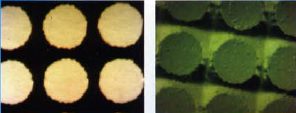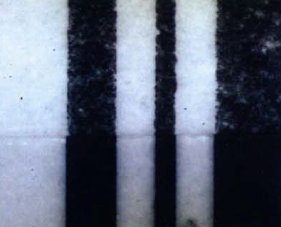Hip to Be Flat
- Nyreeja Cox
- Jul 13, 2022
- 4 min read
Dot Shape Found to Affect Dot Gain


Impression: Perhaps this is one of the most critical factors in quality flexo printing in general, and is even more difficult to control when direct-printing corrugated board. Too much impression causes excessive dot gain and loss of detail, and for corrugated, the appearance of fluting. Dot gain occurs when more ink is transferred to the substrate than is represented by the surface area of the plate. This may be due to over-impression required to get ink density, or simply to the shape of the dot. Fluting occurs when impression of the plate surface varies, due to the irregular surface of the corrugated board, with the flute tips printing darker due to higher impression.
The best plate technologies minimize these challenges. The ideal dot profile offers a maximum range of impression tolerance, and exact imaging of the intended print target. Flat-topped dots, with an engineered bevel, are proving to be ideal.
Over the years, various approaches to plate construction have improved the printing of halftones. Originally, capped-rubber molded plates, and then capped liquid-photopolymer plates, permitted halftone printing. Although bevel angle was not ideal, these technologies permitted the individual halftone dots to compress, while retaining a stable print target, yet the harder durometer capping materials also compromised ink transfer, and were difficult to use on combination plates. Sheet photopolymer, with reduced durometer and control of caliper through extrusion of the raw materials, provided a new level of printing quality, complimenting the improvements in presses, tapes, inks and ink delivery technology. Still, the dot profile was far from ideal. Various approaches were implemented, including foam lamination to plate materials, and single-point light sources, with mixed results and some compromises. Yet, the compressibility of the individual halftone dots, rather than compressibility across the nip of the web, provides the most responsive plate, with minimized fluting and minimized dot gain. Another recent iteration of foam lamination involves removal of the polyester substrate from the plate, and lamination to the unsupported side of foam backing. In this case, although the individual dots can flex better, the dot profile is unchanged and shrinkage and cupping of the mountings over time are undesirable side effects. In 2004, a patent was issued for sheet photopolymer plat processing technique that provided improved dot bevel, at about 26.5 degrees, and offered improved imaging, including 1pt type and 200 line screen. With the ideal bevel to support the dot effectively, yet to permit the dot compression to occur below the print surface, less ink is transferred to the bevel of he dot. The image reproduction more closely matches the imaged plate. Fluting is dramatically reduced. Side-by-side comparisons have proven the effectiveness (See Figures 1 and 2). This technology is optimized for analog (film-based) plates.


Still, digital plates have captured the imagination of flexo printers, and unbeknownst to most, have the least suitable dot profile of all plate technologies. The dot profile of conventional digital plates is quite rounded, even though the bevel angle is better than many analog plates. Digital plates are made from sheet photopolymer with carbon and wax coating applied by the material manufacturer. The carbon and wax is ablated in the image area, by the laser imager, and the remaining wax serves as the negative would, as a mask for the non-image areas. Since the raw photopolymer is revealed after ablation of the mask in the image areas, oxygen retards the polymerization of the photopolymer at the plate surface, which in turn creates the nubby dot profile (See Figure 3).

The rounded profile creates many challenges for flexo printers. The balance between solids and halftones is difficult to manage with impression settings, as digital plates are less tolerant of over-impression. The rounded profile of the dot creates a cutback of strokes and halftone dots, leading some to believe that they print with less gain. However, imaging clarity is compromised, particularly in small type and fine detail. As impression is added to digital plates, the ink rolls easily beyond the intended dot size, and dot gain is difficult to manage. Particularly on direct-printed corrugated, the rounded dot profile makes it impossible to print without fluting of halftones, Still, the digital workflow offers benefits, such as the elimination of film negatives, less opportunity for contamination during plate-making, and improved plate-making efficiencies. The challenge became how to improve the dot profile—how to achieve the flat-topped dot.Incorporating some of the technology discussed above for optimized analog plates, in combination with patent-pending techniques that permit complete polymerization of the intended image areas, a totally new digital plate has been created.

This is a flat-topped dot (see Figure 4), on a true digital plate (with no separate mask and no lamination required). This new dot structure makes individual halftone dots more responsive, as they transfer Some Of the compression to the bevel, instead Of all Of the compression occurring at the face. The relief depth of the plates is enhanced, by 30 percent to 50 percent over conventional digital. The plate surface represents exactly what the laser ablated, and permits control of dot gain without bump curves (see Figures 5, 6 and 7). Dot gain is minimized, and can be easily managed with normal cutback curves. These unique digital plates are available in .045, .067, 090, .107, .125, , 155, and even in -250 caliper materials, and can be made from any commercially available digital sheet photopolymer material. Testing has been done from 45-line screen to well over 200-line conventional screening, proving this plate suitable for brown-box shipping containers or litho-like wide-web applications
Ned Wier, former PRPflexo director of research, invented both patented "ExSpect" and Patent-pending "Digital ExSpect" technology.
Original post: 2008, Edited: 2022








Comments